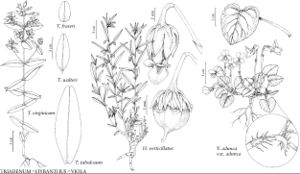Triadenum
Fl. Tellur. 3: 78. 1837.
Herbs, perennial, rhizomatous, glabrous, with glandular canals, lacunae, or dots containing essential oils (pale) in various parts and, sometimes, reddish to purplish gland-dots containing hypericin on stems and leaves. Stems: internodes with 2 or 4 raised lines at first, then terete (not lined). Leaves sessile, subsessile, or petiolate; blade relatively broad, venation pinnate, tertiary-veins densely reticulate, glands punctiform, pale (records of black gland-dots probably all due to fungal attack), intramarginal and laminar. Inflorescences terminal, sometimes also axillary, cymose, 2–15-flowered, or solitary flower, branching dichasial; bracts and bracteoles relatively small. Flowers tubular or campanulate at first, expanding to stellate for short time each day; sepals persistent, 5, distinct or almost so, margins not glandular-ciliate; petals deciduous, 5, partly imbricate or contorted, pink or flesh-colored, sometimes green-tinged; stamens persistent, 9, in 3 fascicles, each with 3 stamens; filaments of each fascicle 1/5–1/2+ connate; anthers yellow, isodiametric to oblate or shortly oblong, with amber gland on connective; staminode fascicles 3, alternating with stamen fascicles; ovary 3-merous; placentation axile; ovules relatively numerous on each placenta; styles distinct, spreading. Capsules 3-valved, with glandular vittae. Seeds narrowly cylindric, carinate; testa reticulate-foveolate. x = 19.
Distribution
e North America, Asia (e China), Asia (India [Assam]), Asia (Japan), Asia (Korea), Asia (e Siberia), Asia (Taiwan)
Discussion
Nomenclatural complexities and confusions associated with Triadenum were reviewed by N. K. B. Robson (1977). B. R. Ruhfel et al. (2011) concluded from molecular studies that Triadenum is part of Hypericum. Robson (2012) gave reasons why Triadenum is generically distinct.
Species 6 (4 in the flora).
Selected References
Key
| 1 | Leaves petiolate. | Triadenum walteri |
| 1 | Leaves sessile or (distal) subsessile | > 2 |
| 2 | Leaves: gland dots intramarginal. | Triadenum tubulosum |
| 2 | Leaves: gland dots laminar and intramarginal | > 3 |
| 3 | Sepals 4–7(–8) mm, apex acute to acuminate; styles 2–3.5 mm. | Triadenum virginicum |
| 3 | Sepals 2.5–5 mm, apex usually obtuse to rounded, rarely acute; styles 0.5–1.5 mm. | Triadenum fraseri |
"broad" is not a number.
